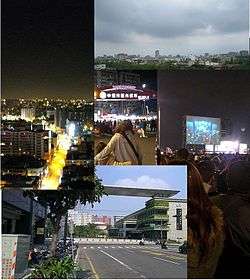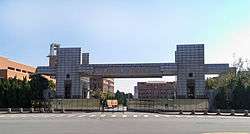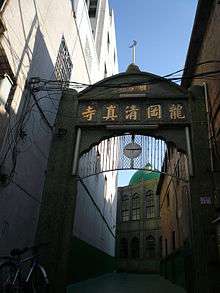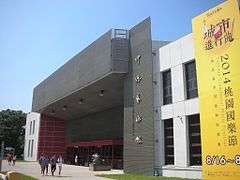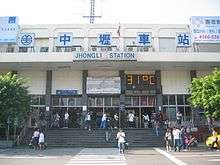Zhongli District
| Zhongli 中壢區 | |
|---|---|
| District | |
| Zhongli District | |
|
Clockwise from top left: Zhongli night skyline, day skyline, 2012 Dec 31 at HSR, Zhongli city library. Center: Zhongli night market | |
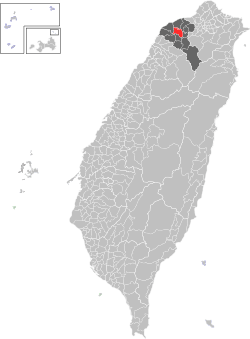 | |
| Coordinates: 24°57′25″N 121°13′25″E / 24.95694°N 121.22361°ECoordinates: 24°57′25″N 121°13′25″E / 24.95694°N 121.22361°E | |
| Country | Taiwan |
| Municipality | Taoyuan City |
| Area | |
| • Total | 76.52 km2 (29.54 sq mi) |
| Population (January 2016) | |
| • Total | 390,251 |
| • Density | 5,100/km2 (13,000/sq mi) |
| Postal code | 320 |
| Area code(s) | (0)34 |
| Website |
www |
| Zhōngli District | |||||||||||||||||||||||||||
| Traditional Chinese | 中壢區 | ||||||||||||||||||||||||||
|---|---|---|---|---|---|---|---|---|---|---|---|---|---|---|---|---|---|---|---|---|---|---|---|---|---|---|---|
| Simplified Chinese | 中坜區 | ||||||||||||||||||||||||||
| |||||||||||||||||||||||||||
Zhongli District (Chinese: 中壢區; pinyin: Zhōnglì Qū) is a district in Taoyuan City, Taiwan. Zhongli is spelled variously as Jungli, Jongli, Jhongli or Chungli on railway, bus stop and road signs. Historically, the city is the site of the Jungli Incident of 1977, the most significant event of the democratization movements of Taiwan prior to the 1980s. Ethnically, it is considered a kind of capital city for the Hakka people, who live in great numbers here and in surrounding areas; a lot of the elderly could speak Hakka in addition to Mandarin and Taiwanese Hokkien.[1] In recent years a large number of foreign workers (mainly from the Philippines and Thailand) have also settled in and around the city due to the heavy industries in the suburbs of the city, making it a center for foreign laborers.[2] The city of Zhongli has 3 large parks and over 70 green reserves in the city for residents of Zhongli to enjoy.

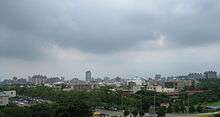
History
In the 19th century, the area was home to Pingpu aborigines. During the Qing dynasty, immigrants from Fujian and Guangdong Provinces arrived along with the Hakka.[3] The original name of the area was Kan-a-lek (Chinese: 澗仔壢; Pe̍h-ōe-jī: Kán-á-le̍k) due to its location between Tamsui and Hsinchu.
During Japanese rule, the town was administered as Chūreki Town (中壢庄), Chūreki District, Shinchiku Prefecture.
After the handover of Taiwan from Japan to the Republic of China on 25 October 1945, Zhongli was assigned to be administered under Zhongli Town Administration Office. In October 1950, it was assigned under Taoyuan County. On 27 February 1967, the Taiwan Provincial Government promoted Zhongli as a county-controlled city and it became Zhongli City on 1 July 1967. On 25 December 2014, Taoyuan County was upgraded to a special municipality named Taoyuan City, and Zhongli City was upgraded to a district named Zhongli District.[4]
Demographics
Zhongli is one of the most multicultural cities due to its convenience and proximity to Taipei (easy to commute). As of 2015, Zhongli had approximately 8,000 Taiwanese aboriginal residents.[5] Zhongli is subdivided into 85 Lis, with the eight biggest Li on the western territory but least populated (39 square kilometers but 35 thousand people), while the eastern side is occupied by industrial factories and the heart of the metropolitan area. This reflects the imbalance of development of the western and eastern Zhongli.
Administrative divisions
Houliao Village, Mingde Village, Zhishan Village, Longci Village, Longxing Village, Longde Village, Longgang Village, Longtung Village, Longchang Village, Longping Village, Renmei Village, Renfu Village, Huaai Village, Puren Village, Puzhong Village, Pujiang Village, Puqing Village, Xinyi Village, Zhengyi Village, Puyi Village, Deyi Village, Renyi Village, Zhongyi Village, Longan Village, Renai Village, Rende Village, Renhe Village, Renxiang Village, Huaxun Village, Zhongjian Village, Xingren Village, Zhongzheng Village, Zhongshan Village, Duhang Village, Zijiang Village, Zhongxing Village, Zili Village, Zixin Village, Zhuangjing Village, Zizhi Village, Neili Village, Chenggong Village, Fude Village, Zhongyuan Village, Zhongxiao Village, Fuxing Village, Fuhua Village, Wenhua Village, Heping Village, Neiding Village, Shitou Village, Zhongyang Village, Xinxing Village, Linsen Village, Zhenxing Village, Tungxing Village, Jianhang Village, Shuiwei Village, Jinhua Village, Zhongfu Village, Xingfu Village, Yongfu Village, Jingpu Village, Xinjie Village, Xingnan Village, Xingguo Village, Xingping Village, Xinghe Village, Yongxing Village, Zhongli Village, Zhongrong Village, Zhongjian Village, Jiuming Village, Xinming Village, Guangming Village, Yongguang Village, Sanmin Village, Wuquan Village, Wufu Village, Zhiba Village, Qiaxi Village, Neicuo Village, Yuemei Village, Shantung Village, Guoling Village.
Economy
Department Store and Shops
Zhongli TRA Station is surrounded by shops on the street and Zhongli also has a SOGO branched department store. Zhongli night market opens daily usually from 6 pm to 1 am. In addition there are two focus of street shops, known as Ta-tung (大同商圈) and Jung-ping (中平商圈), both are within half an hour walk from the Zhongli station.
Industry
The Zhongli-Neili Industrial park was established in 1976 December. This is a Combined multipurpose industry, controlled by the Economic Bureau of Taiwan, with a total area of 433 yards. There are currently 480 companies that have either built factories or offices here, including electronic, metal, chemical, mechanical, food, textile and plastic manufacturers.
Education

Library
- Zhongli City Library, four floors of books, allowed to be borrowed for a month.
- Neili Library
- Longgang Library
Universities
- National Central University
- Chung Yuan Christian University
- Yuan Ze University
- Chien Hsin University
- Vanung University
- Taoyuan Innovation Institute of Technology
- Sheng-te Christian College[6]
Academies and institutes
- Yuan Kwang Buddhist Academy[7]
- Army Academy R.O.C.
Public high schools
- The Affiliated Jhongli Senior High School of National Central University
- National Neili Senior High School
- National Zhongli Commercial High School[8]
Religious organizations
Buddhist Temples
- Yuan Hua Uan
- Un Ping Temple (永平寺)
- Yuan Gaung Chan Temple
- Chi Hui Temple
Christian Churches
- Taiwan Lutheran Zhongli Truth Church
- Zhongli Church of Christ
- Zhongli Christian Bible Church[9]
Muslim Mosque
Tourist attractions
- Jenhai Temple
- Jungshan Park
- Jungte Temple
- Lungkang Park
- Shengchi Pavilion
- Yuankuang Temple
- Zhongli Arts Hall
- Zhongli Night Market
Transportation
Railway
The city of Zhongli is centered around the TRA Zhongli Station. The TRA station is the 3rd busiest station in Taiwan. In addition, there is also Neili TRA station. The only HSR station situated in Taoyuan on the Taiwan High Speed Rail is a 15 min drive from Zhongli downtown, there are free shuttle buses from downtown to THSR station every 15–20 minutes. The Taipei/Airport MRT line is still under construction and estimated to finish in 2016. In addition, the Taiwan Railway Administration Zhongli Station provides conventional train connections to other Taiwanese cities.
Roads
Zhongli is served by both National Highway No. 1 and Provincial Highway No. 66. The nationally owned e-go highway buses, near the Zhongli Station, are an inexpensive means of transport to other cities.
Sister Cities
 Gumi, Republic of Korea (since 1989)
Gumi, Republic of Korea (since 1989) Enfield, Connecticut, United States
Enfield, Connecticut, United States
Notable natives
- Angela Chang, singer and actress
- Candy Chen, dancer, actress, host, singer and model
- John Wu, Magistrate of Taoyuan County (2009-2014)
- Maggie Chiang, singer and songwriter
- Shih Szu, actress
- Wu Po-hsiung, Chairman of Kuomintang (2007-2009)
See also
| Wikimedia Commons has media related to Zhongli District, Taoyuan. |
References
- ↑ "總計畫:客家紮根研究" (PDF) (in Chinese). Archived from the original (PDF) on March 25, 2014. Retrieved January 8, 2014.
- ↑ "經濟部工業局中壢工業區服務中心--首頁".
- ↑ "History". Zhongli City. 2010-06-21. Retrieved 2010-07-03.
- ↑ http://163.29.191.47/en2013/intro/dept2/List.asp
- ↑ "歷年原住民人數比較" [Comparative table of annual aboriginal population figures] (in Chinese). Household Registration Office of Zhongli District - Taoyuan. 2016-02-04. Retrieved 2016-11-07.
- ↑ "Education and Culture". Zhongli City. 2010-06-21. Retrieved 2010-07-03.
- ↑ Yuan Kwang Buddhist Academy, Taiwan.
- ↑ National Zhongli Commercial High School, Zhongli, Taiwan.
- ↑ Zhongli Christian Bible Church, Taiwan http://www.aizhu.com/zcbc
External links
- Zhongli City International Information website (Chinese)
- Zhongli City website (English)
- Taoyuan County Government's Cultural Affairs Bureau (English)
- Zhongli Industrial Park Service Center (Chinese)
